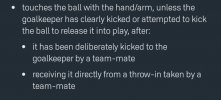LiftedLorax
New Member

Let's say that the goalie is playing very advanced, takes a short pass from a teammate then dribbles back to his penalty area and picks the ball up. Still a backpass? What if the keeper hoofs it to his own area and picks it up - still a backpass?
How is the ball defined as being "released into play"?



